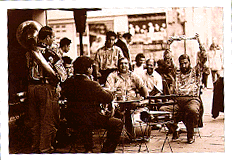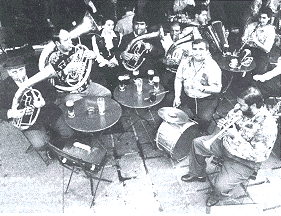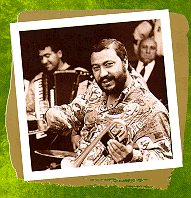
No Strings Attached

|
Kochani Orkestar: Naat Veliov - truba and direction Vinko Stefanov - accordion Erol Asimov - saxophone, clarinet Ismail Ismailov - drum (tapan), darabuka Violeta Filipova - voice Orhan Veliov - tuba Mendu Saliev - bariton Dalkran Asmetov - bariton Sadedin Durmisov - bariton Estan Amedov - golem |
|
|
 A certain genius particular to Gypsy musicians and the Rom people has
allowed them to adopt and transform the indigenous music of the regions
they traverse, thus facilitating the integration and evolution of musical
styles and songs specific to various cultures and ethnic groups.
A certain genius particular to Gypsy musicians and the Rom people has
allowed them to adopt and transform the indigenous music of the regions
they traverse, thus facilitating the integration and evolution of musical
styles and songs specific to various cultures and ethnic groups. From Albania to Turkey, Greece to Bulgaria, the Balkans region represents
a multitude of forms of expression with extremely diverse ethnic
origins. Nevertheless, a certain musical tendency which reflects the
ancient Ottoman occupation remains at the heart of this complex rural and
pastoral mosaic. The Oriental aspect of Balkan music seems to be
maintained particularly by the Gypsys who moved out from Turkey starting
immediately after the Ottoman occupation in the 14th century. There is
also the factor of the Gypsy's own Oriental heritage in their Indian
roots which plays an important role in their musical style.
From Albania to Turkey, Greece to Bulgaria, the Balkans region represents
a multitude of forms of expression with extremely diverse ethnic
origins. Nevertheless, a certain musical tendency which reflects the
ancient Ottoman occupation remains at the heart of this complex rural and
pastoral mosaic. The Oriental aspect of Balkan music seems to be
maintained particularly by the Gypsys who moved out from Turkey starting
immediately after the Ottoman occupation in the 14th century. There is
also the factor of the Gypsy's own Oriental heritage in their Indian
roots which plays an important role in their musical style.